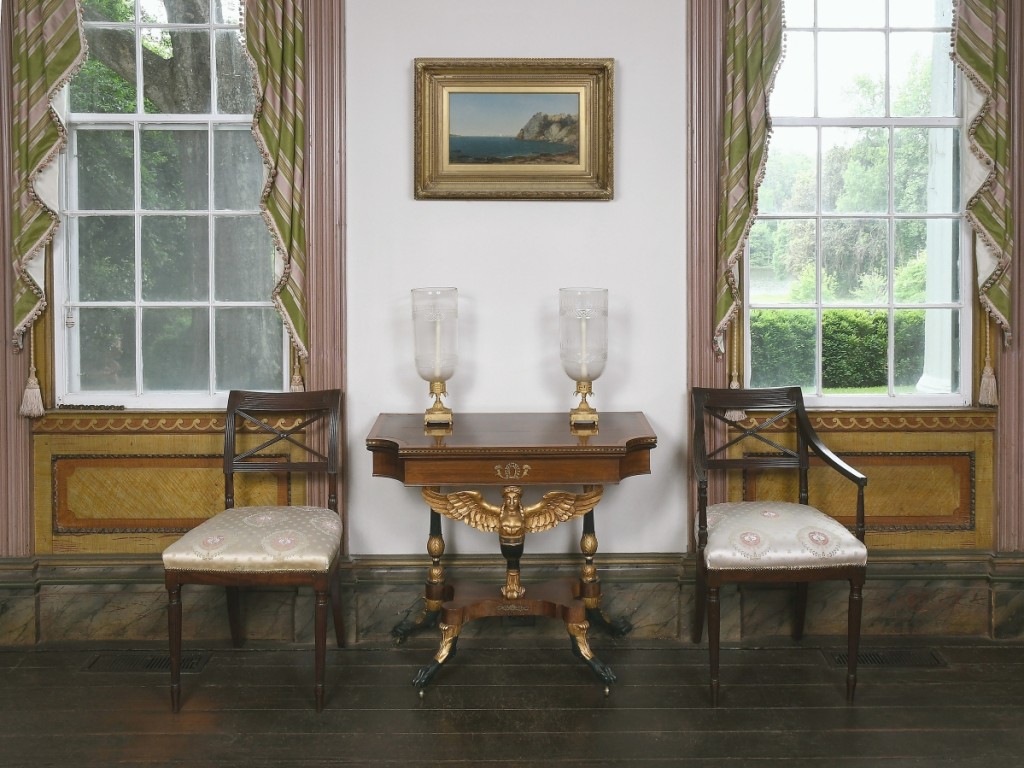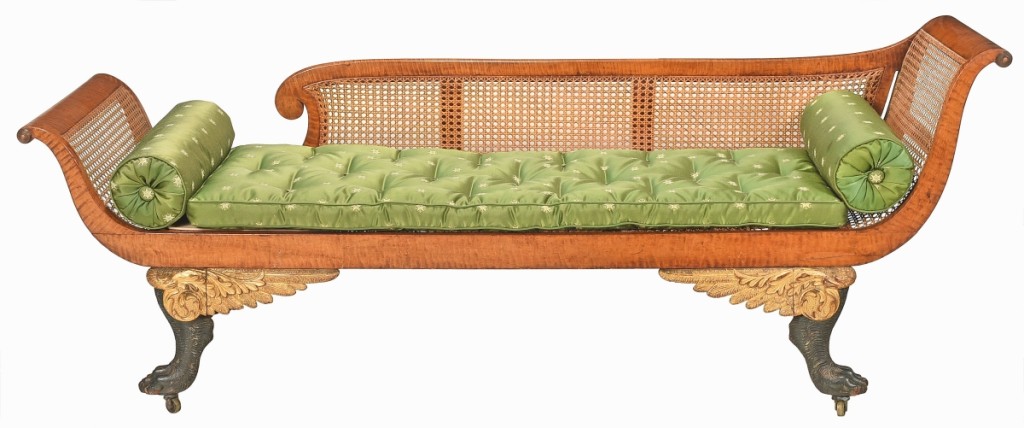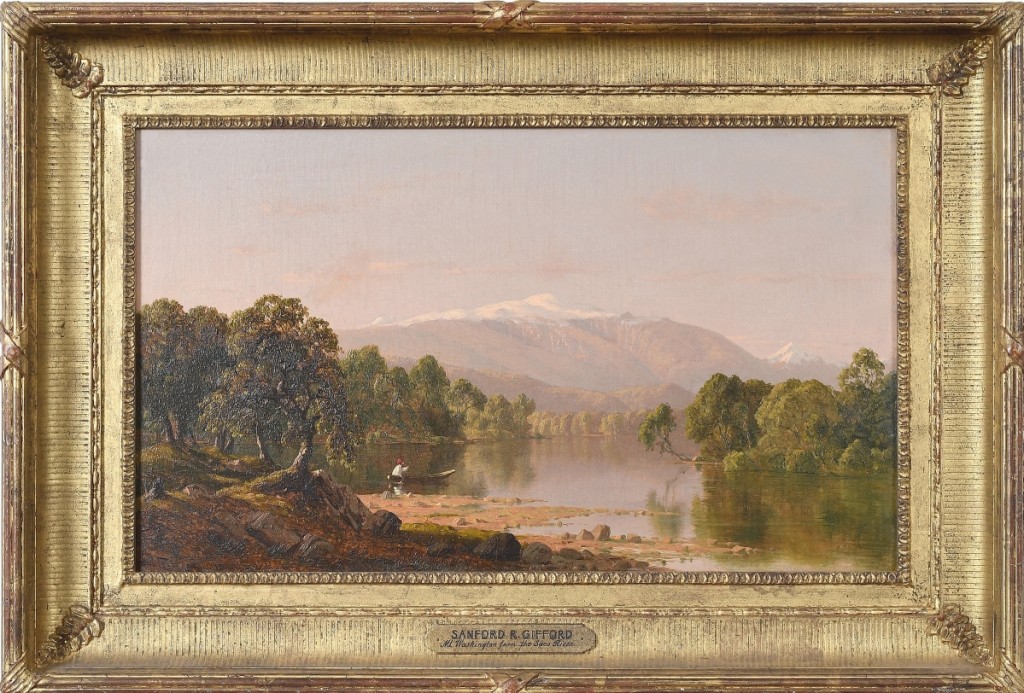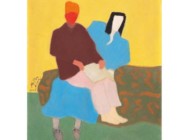
Here, in a photo staged by Brunk Auctions at Bankshaven, two Federal chairs flank the swivel-top card table possibly made by Phyfe, 1815-1820. Above hangs the 1856 oil on canvas “Beacon Rock, Newport” by John Frederick Kensett.
By Laura Beach
ASHEVILLE, N.C. – William N. Banks Jr, who died last November at age 95, was the model of a scholar collector, his work as a regular contributor to The Magazine Antiques dovetailing with his passion for preserving historic homes of his own in Georgia and New Hampshire. Banks appointed each residence with a sympathetic mix of Federal and Classical American furniture and Nineteenth Century American paintings. He filled his library with antiquarian volumes bespeaking his passion for architecture, landscape and travel.
In a much-anticipated addition to the fall arts calendar, Brunk Auctions will sell the contents of Bankshaven, the collector’s carefully tended property in Newnan, Ga., on September 12. The single-owner sale consisting of roughly 300 lots will be accompanied by a print catalog designed both as a well-documented reference and an enduring tribute.
Visitors to what Banks himself referred to interchangeably as Bankshaven and the Gordon-Banks house, the latter acknowledging the property’s first owner, were uniformly impressed. “I know of no more comfortably authentic, untouched, all original house in America,” Morrison H. Heckscher, former chairman of the American Wing at the Metropolitan Museum of Art, wrote his host after a stay. Cultural observer Brendan Gill averred, “In architecture I can think of few more delightful examples of cultural cross-fertilization than the country house in Coweta County, Georgia belonging to the writer, historian and collector William Nathaniel Banks.”
Skillful as a host and steeped in the rituals of gracious entertaining, Banks was a Southern gentleman of the old school. “He was stylish, elegant, polite and cultured. It was always a delight to see him. “A Charmed Life,” his loosely autobiographical account published in Antiques‘ May/June 2015 issue, captures him well,” says auction house president Andrew Brunk, who recently visited Bankshaven while inventorying the collection. “Being there and seeing how he lived – the collections, sculpture, gardens and fountains – transported us to another time. The house is an architectural gem. We saw the vestiges of a remarkably wonderful life.”
Born in Newnan in 1924 to a successful investor and his wife, Banks left Dartmouth College to serve in the US Army infantry during World War II, completing a degree in drama at Yale University in 1948. In addition to his writing on historic art and architecture, Banks, a playwright, was a four-time fellow at the MacDowell Colony in Peterborough, N.H. He was a long-serving member of its board, as well as that of the High Museum of Art in Atlanta.
“He wrote for Antiques for more than 40 years, always with the historian’s attention to detail and the playwright’s flair for character and sense of time and place. Nobody else ever did it quite the way he did. He never mastered email or a computer, or even, really, a cell phone, but he dug deeply into every subject he covered for the magazine, from historic houses and towns to individual artists and artisans, and readers always loved his stories,” Antiques consulting editor Eleanor H. Gustafson wrote in an email earlier this year.
Karma seems to have led Banks to his Georgia residence. He had already acquired a Federal house in Temple, N.H., the birthplace of Daniel Pratt (1799-1873), an architect-builder who migrated to Georgia, where in the 1820s he built a house near Milledgeville for planter John W. Gordon (1797-1868). A local college professor, L.C. Lindsley, saved the Gordon house, by then all but derelict, in the 1940s.
Banks writes, “In 1959, having seen photographs taken for the Historic American Buildings Survey in the 1930s, I contacted Lindsley, and he graciously gave me a tour of the property. I was awestruck by a unique house that had remained virtually unaltered for more than a century; and, I confess, I fell in love.” Banks persuaded his recently widowed mother to buy the building in 1968. Under the supervision of architect Robert Raley, it was reassembled in Newnan, 40 miles southwest of Atlanta, amidst gardens begun by Banks’ parents in the late 1920s. The family razed their existing Tudor-style home to accommodate the structure.
Finding himself with an empty house, Banks began collecting for it. Beginning in the late 1960s, he bought at auction in New York, where he kept an apartment, and from leading dealers, among them Vose, Spanierman and Hirschl & Adler Galleries, where in 1972 he paid $150,000 for “Franconia Range from the South with Village of South Woodstock, New Hampshire,” an important work of 1857 by Asher B. Durand and a highlight of the upcoming sale, and a Raphaelle Peale still life. The collection includes other New Hampshire views by Cropsey, Gifford and Shapleigh.
“I met William in the early 1980s when I was working at Alexander Gallery,” says Brunk Auctions general manager and fine arts specialist Nan Zander, who spent 35 years in the New York art world before moving to Asheville. “One of the first important paintings I sold, the 1856 ‘Beacon Rock, Newport’ by John F. Kensett, was to William. It’s now hanging in my office. I feel I’ve come full circle. William bought the best of the best that was appropriate for his home.”
“He became very interested in his wonderful collection of paintings and was very knowledgeable,” says Banks’ longtime friend James Landon, a retired attorney asked by Brunk to write the catalog’s introduction. “He had more than one Raphaelle Peale. Every time I entered his dining room, I marveled at his still lifes, all little jewels, each lighted exactly right. It was the most beautiful thing. The landscapes were in the drawing room. It really was like going to a gallery.”
“There are some exciting pieces of furniture, some thought to have Southern histories,” says Andrew Brunk, summoning to mind a tiger-maple Grecian sofa with a caned back and sides and verd antique and gilt feet. Among other furniture highlights is a set of six lyre-back klismos chairs with Middleton family history that are attributed to Duncan Phyfe, circa 1815; a Classical marble top pier table attributed to J.&J.W. Meeks, circa 1830; and a marble top center table attributed to Anthony Quervelle, circa 1829. A New York caryatid card table previously attributed to Charles-Honoré Lannuier but now thought possibly to be by Phyfe, 1815-20, came from Banks’ cousin, Olive Pringle Brown, who inherited it from her family, said to be former owners of Charleston’s Pringle house.
Pulling brown-paper lining from the last drawer of a sideboard, Brunk found a signature, the date July 3rd, 1817, and the words Keene, New Hampshire. “As anyone in this business knows, it’s great fun to chase down details when you’re looking at good quality things,” says the auctioneer, whose team is in the midst of cataloging the sale.
In Antiques, Banks wrote of his fascination with Humphry Repton (1752-1818) and speculated on the English landscape designer’s possible influence on William C. Pauley (1893-1985), the American designer who worked with Banks’ father to create at Bankshaven what the collector called “a pleasing landscape in the English style.”
“William had a genuine passion for architecture and gardens and collected some wonderful, early books on the subject by Alexander Jackson Davis and others,” says Brunk, who looks forward to selling two rare Repton volumes. Where possible, the collector’s research relating to specific paintings and objects will accompany sold lots to their new owners.
Brunk Auctions is pulling out all the stops for the Banks sale. Andrew Brunk says, “We are thrilled and honored to offer this collection. It’s a great fit for our company.” That, and an eagerly anticipated prelude to the season ahead.
Consistent with public health directives, the collection of William Banks will be available for viewing by appointment at Brunk Auctions’ Asheville gallery at 117 Tunnel Road. For information, 828-254-6846 or www.brunkauctions.com.

















